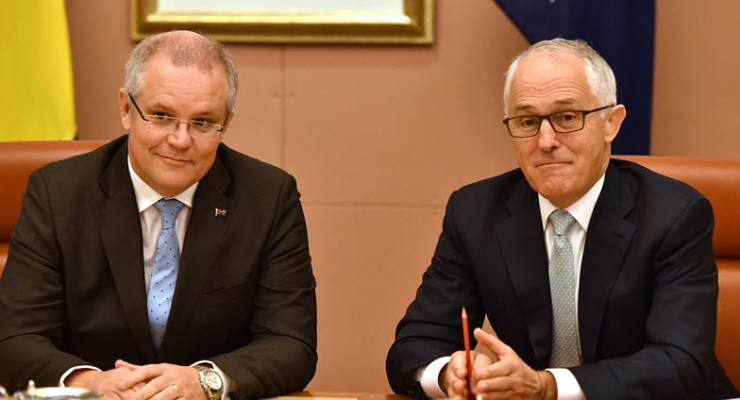
After more than 18 months of being accused of being captive of the right of their party, Malcolm Turnbull and Scott Morrison have shifted radically to the centre in a desperate move to save their government. Tonight’s 2017 budget is a tax-spend-and-borrow document designed to appeal to voters’ populist instincts. Strip the names and dates off this budget and it could easily be mistaken for a Labor budget.
In fact, with the government’s “private school hit list”, stoush with Catholic schools over education funding and an outright assault on the big banks via a new billion-dollar tax, this is a budget that goes where Labor wouldn’t dare. And Turnbull and Morrison haven’t merely taken Gonski off Julia Gillard. They’ve taken her NDIS funding as well, bumping up the Medicare levy from 2019, for good. What next — a carbon price?
Labor backed the inland rail line, too, but that’s now to be a signature National Party project and a demonstration not merely that the government is prepared to invest in infrastructure, but also prepared to look after the bush — although how exactly regional NSW will benefit from a pointless train line is a mystery for Nationals infrastructure ministers of coming decades to explain.
There’s also an expensive attempt to fortify the government against a repeat of Mediscare. There’ll be $1.2 billion extra for Pharmaceutical Benefits Scheme listings (almost half devoted to cardiac drugs) and money for mental health, as well as an additional $1 billion to end the freeze indexation on some MBS items – initially the bulk billing incentive payment. But the real anti-Mediscare initiative is hilarious: the government is playing a pea-and-thimble trick with revenue from the Medicare levy and, separately, from personal income tax, which will be paid into a “Medicare Guarantee Fund” to somehow guarantee Medicare and PBS funding into the future despite making precisely no difference in funding.
Fortunately, such silly buggers stuff is rare in the document. The economic forecasts look a lot more rigorous than in 2016, and again the government has erred on the side of caution on crucial iron ore and coal prices. There’s nothing to frighten the ratings agency horses here, especially with new taxes featuring so heavily.
The image being projected is the one that gave Malcolm Turnbull a huge polling surge when he became leader – a can-do government committed to building things and governing from the sort of sensible centre voters like. Indeed, it’s actually hard to think of how much more Labor-like a Liberal government could have gone and survived.
Will it work?
There’s no such thing as a “budget bounce” when it comes to polling, but if this doesn’t succeed in getting voters to reconsider Turnbull, nothing will — he’s gone all out to restore some sense of what voters expected of him, the absence of which has disappointed them so badly in the last 18 months, But while voters may be prepared to assess the budget on its merits, and perhaps even give Turnbull another chance, it’s likely to infuriate sections of the right within the Liberals (the Nationals will be happy with massive regional pork barrelling, especially in NSW).
What’s the point, they will ask, of being in the Liberal Party if it’s going to govern like Labor? Why is the deficit, and spending, continuing to grow? Why are there two big new taxes in the budget – one on voters, one on traditional Liberal allies the big banks?
That’s the risk for Turnbull and Morrison, and what makes this document a desperate political gamble. The biggest threat to this budget isn’t on the other side of Parliament, or on the crossbenches – it’s sitting behind Morrison as he delivers his budget speech. If this budget doesn’t click with voters, that threat will crystallise and remove both men before the end of the year.








I can’t disagree that the ALP would not dare to propose such a Budget for fear of the rabid mudorc press.
The sad thing is that they would not want to do so.
Its not brave to put a $6.2 billion tax on the banks its just a typical Liberal attack on low and middls income earners who are the banks bread and butter customers, that levy will be passed on to them in higher interset rates and fees
The rich – like good old Malcolm – have personalised banking arrangements wont have to pay and he poor cant pay – so just another great big Liberal tax on low and middle income earners
And I wouldnt doubt that the banks will be forthcoming in telling us that the increase in borrowing costs is in part due to the levy as a 2 finger salute to these bozos
I feel like Rip Van Winkle – the media this morning sounds like it’s all done and dusted? ‘Promises kept and delivered on trains running to timetable’?
…… Unlike their carry-on the day after a Labor Budget?
What, was there nothing on climate change? Nothing about beefing up ARENA, that money making venture capitalism source of funds? Nothing about increasing the RET? No carbon tax? No end to the capital gains gift to the wealthy?
You’re correct in that if Labor tried to put this through the rancour from the right would be substantial and the Murdoch press would be all over it. And AR is right that Labor probably don’t have the courage to try something like this on, but it’s a long way from what would be a really good budget. But much better than could be reasonably expected.
God we are a long way from good government. I don’t even mind the inland railway, at least it is money being spent in the real economy. God knows, the kids who can’t afford to buy in Sydney and Melbourne might end up using it.